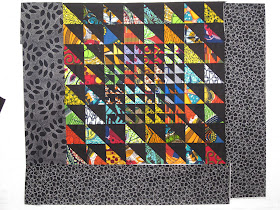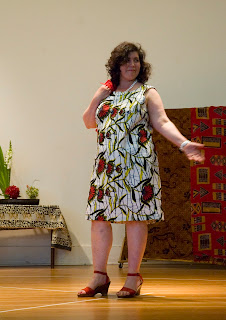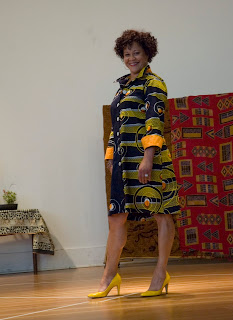I thought you would enjoy seeing some more of the exhibit from the Textile Museum of Canada (Toronto). First is this "apron", worn by men from Papua New Guinea. It looks very like similar artifacts from various African countries. I love the black and neutral mini checkerboard that divides up some of the rows, and would love to incorporate something similar into some of my own work. Next is painted barkcloth from the DRC (Democratic Republic of Congo). The barkcloth itself is very much the same as I've been able to find in Uganda, but the artwork is quite different.
This carpet is from Morocco. Utterly gorgeous. Woven by the Berbers, it would have been placed underneath a better quality carpet. It's made from dwarf palm leaves. Don't you love all those half-square triangles. Next is a skirt made by the Dida people of Cote d'Ivoire. I wonder how the motifs were imprinted on the dark background. It looks very much like a resist of some kind.
Lastly is this Nigerian stencil, made from sheet metal that once lined tea chests that came to Nigeria from the Far East. The stencil was used to apply a resist paste made from cassava and yams before the cloth was immersed in an indigo bath. Indigo from Nigeria is still some of the most beautiful in the world. Now the challenge for me is how to take all these wonderful sources of inspiration, not just from the Textile Museum, but from all the artifacts and photos I've been collecting over the last few years, and incorporate them in my own work. For the first time in many years, I have a long stretch of three months in front of me with no commitments. Well, just a few. And this is how I plan to spend my time. Working improvisationally - the work of people like Jean Wells, Rayna Gilman and Gwen Marston is mentoring me in this latest endeavour - with African motifs and designs as inspiration, to make my own work. I have the time, the ideas, the space, and the inspiration. Nothing to stop me except my own self. Here I go . . .
Wednesday, October 31, 2012
Wednesday, October 24, 2012
Textile Museum of Canada
Last weekend I attended the 40th Reunion of my graduation from the Wellesley Hospital School of Nursing, in the Toronto area. I was so glad I decided to go. We spent two years living in residence together, and a third year living in apartments that we shared, while we worked for the hospital. Lots of memories, and lots of life lived since then. And then I had the added treat of spending a couple of days with my oldest friend from high school. And as a special treat, I managed to fit in my first visit to the Textile Museum of Canada, located in downtown Toronto. While fairly small, the exhibits were magnificent. "Natural Resources" was of particular interest to me, with many examples of African textiles. The first example is of Tanzanian barkcloth, made from the bark of fig trees, and then painted with natural pigments. The variety of triangle shapes seen here - painted "improvisationally" - suggest quilt patterns to me.
This second piece is part of a dance skirt made in the Congo, and is over a hundred years old. Again there are dense triangles in the border, as well as cowry shells and embroidery with natural fibres adding decorative elements.
This hat also comes from the Congo, and would have been worn by a lesser official, signified by the guinea fowl feathers. Higher officials would have worn hats decorated with eagle feathers.
This is just one of the beaded necklaces on exhibit, this one coming from South Africa. It is a Zulu design, in which the colours all have significance - white for purity, blue for fertility, and black for darkness.
This last piece is a ceremonial dance skirt from Congo, on which abstract symbols are appliqued on a raffia wrap-around for women. I wish I knew what the shapes signify. I'll post a few more photos in the days to come, but this gives you an idea of the rich collections at the museum. And they have a terrific website for anyone who's interested - especially wonderful for those of us who rarely if ever get to go to Toronto - www.textilemuseum.ca.
This second piece is part of a dance skirt made in the Congo, and is over a hundred years old. Again there are dense triangles in the border, as well as cowry shells and embroidery with natural fibres adding decorative elements.
This hat also comes from the Congo, and would have been worn by a lesser official, signified by the guinea fowl feathers. Higher officials would have worn hats decorated with eagle feathers.
This is just one of the beaded necklaces on exhibit, this one coming from South Africa. It is a Zulu design, in which the colours all have significance - white for purity, blue for fertility, and black for darkness.
This last piece is a ceremonial dance skirt from Congo, on which abstract symbols are appliqued on a raffia wrap-around for women. I wish I knew what the shapes signify. I'll post a few more photos in the days to come, but this gives you an idea of the rich collections at the museum. And they have a terrific website for anyone who's interested - especially wonderful for those of us who rarely if ever get to go to Toronto - www.textilemuseum.ca.
Wednesday, October 17, 2012
What Happened Next?
When I wrote this blog a couple of weeks ago, I was working from the centre out on a new quilt, using two sizes of half-square triangles made from African wax fabrics and from solid black fabric. I left you hanging, while I decided what came next. My original idea had been to put squares of different yellows around the centre half-square triangles, and use that as a background, but when I tried that out, the contrast between the black and the yellows was just too much. So that idea had to be ditched. Next I tried out several white on black fabrics, but none of them seemed quite right, until I used two different white on blacks, and sewed them on like I was sewing a Bright Hopes block, with one fabric on the top and the bottom, and the second fabric on both sides of the centre.
I still wanted to put applique shapes - baobab trees and animals, I thought, on the background. But the trees, which I put in each of the four corners, looked like shrivelled up bits of seaweed, not the magnificent giants of sub-Saharan Africa, so off they came. And then the simplest idea of all came to me - why not put circles in three or four sizes on to opposite corners - liberated circles, I like to think of them that way, dancing away to their own music, while the more rigid and mathematically-inclined triangles hang onto their precision and points. I liked this much better. Now it needs to be quilted, and named, and bound in more scrappy lengths of African fabrics. Now I can move onto the next quilt. I think there might be hope for me - seeing one thing through before moving onto the next. Sort-of. Make that working on 4 or 5 quilts at a time before moving onto new ideas. That's an improvement, for sure.
I still wanted to put applique shapes - baobab trees and animals, I thought, on the background. But the trees, which I put in each of the four corners, looked like shrivelled up bits of seaweed, not the magnificent giants of sub-Saharan Africa, so off they came. And then the simplest idea of all came to me - why not put circles in three or four sizes on to opposite corners - liberated circles, I like to think of them that way, dancing away to their own music, while the more rigid and mathematically-inclined triangles hang onto their precision and points. I liked this much better. Now it needs to be quilted, and named, and bound in more scrappy lengths of African fabrics. Now I can move onto the next quilt. I think there might be hope for me - seeing one thing through before moving onto the next. Sort-of. Make that working on 4 or 5 quilts at a time before moving onto new ideas. That's an improvement, for sure.
Thursday, October 11, 2012
African Marketplace in Nanaimo
Back in May of this year, an African Marketplace took place in Nanaimo, BC, and the Bitengye Designers were invited to be a part of it. Funds raised went to the Stephen Lewis Foundation. We had one of several sale tables, with our wax fabrics and Bitengye items available for purchase and where Trudy Thorne ably managed the brisk trade. But the highlight of the gathering was the fashion show. I've posted photos of several of the garments modelled, all made from fabrics from Kitambaa. I think they're gorgeous, especially the cowry shell jacket seen below.
And isn't this tunic smashing? I wonder if we should ask the Bitengye women to make up a few of these, and see how sales go here at home? Love the zebras below too.
And how about this coat? What fun! While we don't have Alice and the other Bitengye women making these garments, they have just started work on two styles of dress for "traditionally built women", and a casual jacket. I'm hoping they will be ready to ship to us well before Christmas, so we can offer them to you for sale. I'll keep you posted. In the meantime, these photos might give you ideas of your own in how to use our wonderful fabrics.
And isn't this tunic smashing? I wonder if we should ask the Bitengye women to make up a few of these, and see how sales go here at home? Love the zebras below too.
And how about this coat? What fun! While we don't have Alice and the other Bitengye women making these garments, they have just started work on two styles of dress for "traditionally built women", and a casual jacket. I'm hoping they will be ready to ship to us well before Christmas, so we can offer them to you for sale. I'll keep you posted. In the meantime, these photos might give you ideas of your own in how to use our wonderful fabrics.
Sunday, October 7, 2012
Hornby Community Quilt 2012
Every year, for many, many years now, a community quilt is made on Hornby Island. This year's theme was water, and the proceeds from the quilt went to the Water Committee. (Although this island is surrounded by water, and receives considerable rain every winter, ground water is still a precious resource.) Background fabric and three or four other possible fabrics are distributed to everyone who would like to participate - mostly 12" X 12" squares, with a few squares that are double that.
After that, it is entirely up to each individual how they would like to interpret the theme. The close-up gives you a better idea of the diversity of blocks, which are then put together with sashing by the Hornby Quilters. Tickets go on sale outside the Co-op all summer long, where it hangs underneath a specially constructed roof, and astonishes visitors and locals alike. My own block is of two kayaks pulled up on the beach at Grassy Point. I'm not sure if the ticket has been drawn yet for the winner - I know that I haven't had a phone call yet! Whoever that lucky person is, they will the owner of a true work of art. Congratulations to all who pariticipated in making the quilt. It's a beauty, once again.
After that, it is entirely up to each individual how they would like to interpret the theme. The close-up gives you a better idea of the diversity of blocks, which are then put together with sashing by the Hornby Quilters. Tickets go on sale outside the Co-op all summer long, where it hangs underneath a specially constructed roof, and astonishes visitors and locals alike. My own block is of two kayaks pulled up on the beach at Grassy Point. I'm not sure if the ticket has been drawn yet for the winner - I know that I haven't had a phone call yet! Whoever that lucky person is, they will the owner of a true work of art. Congratulations to all who pariticipated in making the quilt. It's a beauty, once again.
Thursday, October 4, 2012
Up for a Challenge
Up for a Challenge Art Quilts is the name of an online 12 X 12 group that I belong to. The idea is that every 3 months we will all make a quilt to fit the theme chosen for that quarter. The theme this time was Incandescence. I had piles of already-fused fabrics left over from a Sue Benner class I took last spring. I had a lot of fun creating this glowing "something" (sun? fireworks? sparkler?) with some of those fabrics. The tricky part was keeping all the fabrics in place while I was arranging them. I learned to fuse a row or two at a time, between layers of a Teflon pressing cloth. Then I could peel it off and add the next layer, working all the time from the centre out to the borders. To see more of the results of this challenge, you can google Up for A Challenge Art Quilts. I think that will take you there.

























